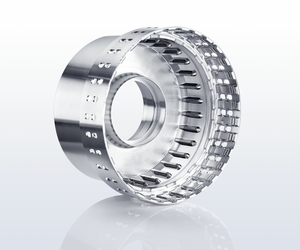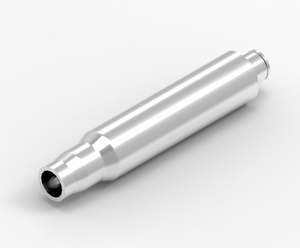Flow-Forming - Creative freedom for complex shapes
The flow-forming technology gives us and our customers increased design freedom in terms of complex shapes and varying wall thicknesses. In the field of rotationally symmetrical components, flow-forming technology is a milestone in cold forming. Flow-forming is a process in which a blank is positioned on a shape-giving core and set in rotation before the material is cold-formed from the outside by driven rollers and pressed against the core. The process can be combined with various mechanical finishing processes as well as hardening and deburring processes precisely adapted to the required specifications.
A milestone in cost-oriented process optimization
Where other cold forming processes reach their limits, the design possibilities with flow-forming are just beginning. Flow-formed parts provide far-reaching advantages in many applications. Whenever rotation-symmetrical parts with varying wall thickness profiles, challenging inner shapes, splines or stretched areas are required, flow-forming should be considered. In many applications, it is also possible to substitute multi-part welded assemblies with a single-piece flow-forming solution.
The raw part is designed individually for each application. This can be, for example, a blank, a formed deep-drawn part or a forging. Various steels or aluminum can be used as materials.
Through flow-forming, high-quality surfaces can be produced on the parts. The enormous cold work hardening means that subsequent hardening processes for the components can often be eliminated or limited to certain areas.
In addition to the process costs themselves, where flow-forming has advantages over other processes, the technology is also characterized by low tooling costs. This means that even small quantities can be produced cost-efficiently. The production of prototypes close to series production is usually possible within a very short time.
- Our flow-forming technology scores and convinces through:
- Integral design by complex cold forming
- Production of even complicated shapes
- High cost efficiency due to better material utilization compared to forging and machining technology
- Cold work hardening and high surface quality
- Processing of different raw materials and semi-finished products such as sheet metal or forging blanks
A high degree of precision in flow-forming and the combination with various other processes brings not only quality advantages, but also a significant cost advantage.


![[Translate to Englisch:]](/fileadmin/_processed_/3/7/csm_header_drueckwalzen_002_1a2370302a.png)

